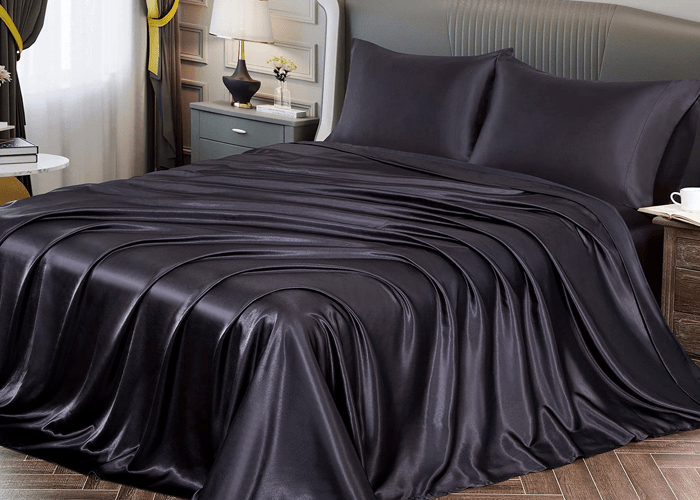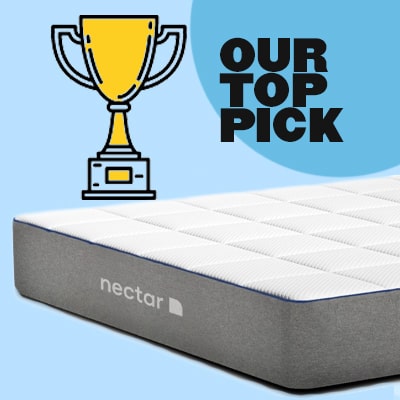Have you been looking for new sheets and come sateen and percale? To help you decide what is best for you, we put together this post.
We will look at:
- The difference between sateen and percale.
- Is sateen or percale better?
- What’s cooler, sateen or percale?
- What sheets do hotels use?
What are sateen and percale sheets?
Sateen and percale are words to describe a weave pattern rather than a material. This difference in the weave pattern produces a difference in the look of the sheet and its feel. The weave pattern affects the appearance, shine, and softness. It should also be taken into consideration when looking at the thread count of certain sheets.
Let’s briefly discuss the difference between the two weaves.
Sateen
Sateen weaving is a weave of one yarn under and three to four yarns over to. This weaving pattern is what makes up the silky and smooth buttery feel of sateen sheets. Because of this, the fabric has a subtle shine, and it drapes nicely. It drapes nicely because it is naturally wrinkle-resistant, so it looks smooth and wrinkle-free without the need to iron it.
If you like a smooth and luxurious feel, you should go for sateen sheets. In terms of durability, sateen sheets start silky smooth, but pills and snags are bound to emerge as the sheet is used regularly. Additionally, sateen weaves are also low-maintenance as they require no ironing to look pristine.
While sateen may have a looser plain weave, it produces a sheet that traps heat efficiently because it uses a thicker yarn size. This may be preferable if you live in a chilly environment. Otherwise, you are better off going with percale sheets as they have a cooler feel.
Percale
Percale sheets, on the other hand, have a regular one thread over another pattern. This weaving pattern produces a tighter and more crimp weave. The overall product feels crisp and smooth to the skin.
While percale does have a tighter pattern, this doesn’t automatically mean that it’s dense and makes for a hot sleeping environment. In fact, it’s the exact opposite. Percale sheets are considered to be the best sheets for those who like to sleep cool.
It produces a smooth matte finish that is similar to a dress shirt that is ironed down. Unlike sateen, percale is also pretty vulnerable to wrinkles. This is why most people prefer to iron it after washing to hold its crisp shape. Additionally, percale starts smooth and crisp, but it gets even softer as it is worn over time.
Is sateen or percale better?
It’s not often you purchase new sheets, and It’s challenging to pit sateen and percale sheets against one another. For one, sateen and percale refer to weave patterns and not materials. Different materials can be used for both patterns, and the variations between these materials affect the overall performance of the sheet.
Moreover, the question of which is “better” is entirely subjective. Each weave pattern offers its advantages and disadvantages. The desirability of these benefits and demerits largely depends on your preference and your personal choice of how you want to sleep.
That being said, below is a table that presents the differences, advantages, and disadvantages of each weave.
| Quality | Sateen | Percale |
| Feel | Soft, silky, and luxurious | Soft and crisp |
| Maintenance | Little to no maintenance, Wrinkle-free | May require ironing for a crisper feel |
| Appearance | Subtle shine | Soft matte |
| Durability | May develop pills and snags over time | Becomes softer with use |
| Heat retention | Retains heat well | Most breathable sheets |
Based on the table, sateen sheets are recommended if you are willing to sacrifice sleeping cool over a low-maintenance and luxurious sheet. It is perfect for those who live in hotter climates and need an extra layer of heat. Additionally, if you are looking for low-maintenance but luxurious and soft sheets, sateen is the way to go.
Whereas, percale sheets are perfect for those who sleep hot or want more breathability. However, because they aren’t as soft as sateen sheets, if softness is your main criteria, you might want to opt for sateen instead.
Which is cooler: sateen or percale?
The answer to this is that percale sheets are cooler.
Percale does have a tighter, one over one thread pattern. However, because the diameter of the threads used in percale weaving is smaller than sateen, it produces a lighter sheet. This lighter sheet is breathable and allows air to pass and circulate underneath the sheet correctly.
The coolest and most breathable percale sheets that you can buy are those made with the material cotton. Cotton is moisture-wicking and naturally breathable, which is further amplified by the percale weaving.
On the other hand, sateen sheets are heavy and are known to trap heat very well. Silk and nylon are materials that produce satin when weaved in a sateen pattern. These also feel cozier and softer.
Hotel sheets: sateen or percale
Hotel bedrooms feel incredibly relaxing. If you’re looking to replicate the feel of hotel beds, a great way to start is to get the sheets right. We’ll look at the weave pattern and kind of sheets that hotels use.
The most common kind of sheets that you will find in hotels is cotton percale with a thread count of 300-600. Cotton is a naturally hypoallergenic, extremely breathable, and soft material. This makes it perfect for all kinds of sleepers who check in hotels.
Cotton percale sheets result in a tight and crisp look, creating that iconic sleekness of every hotel’s classic. Additionally, it is also very durable and has a soft and breathable feel. However, it is not uncommon to see cotton sateen sheets as well.
Cotton sateen is the usual type of sheets you’ll see in hotels as silk and nylon sateen sheets are too delicate for the rough handling that hotel beddings undergo. However, sateen sheets feel very luxurious and are also wrinkle-free, keeping that pristine, low-maintenance look.

 Nectar Mattress
Nectar Mattress 


